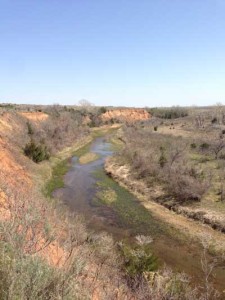Rio Grande wild turkeys inhabit parts of the country that are generally pretty harsh. Rio’s live in the brushy areas near water sources and areas of scrub oak and mesquite. There is one factor that determines whether or not Rio’s inhabit a piece of property, and that one factor is water. Without a water source, Rio Grande turkeys cannot survive, and without a water source on your hunting property, you will have no turkeys. Many landowner’s in these arid areas build ponds, both large and small, to help hold water in the driest of times. The NWTF also has a Guzzlers for Gobblers program in place to help increase the amount of water available to wildlife in these areas. The program includes building catchment areas to hold runoff rain water, building water guzzlers that will hold rainwater or even well water, and improving riparian habitat by removing invasive plant species that consume great amounts of water. This Guzzlers for Gobblers program has helped to enhance millions of acres for all wildlife in New Mexico, Arizona, Nevada, Texas, Oklahoma, Utah, Colorado, and other states. Another wildlife habitat improvement project the NWTF is spearheading is the Southern Great Plains Riparian initiative. This project is helping landowners and communities in Texas, Kansas, Oklahoma, and Nebraska to maintain and restore wooded areas in the southern Great Plains. For more information about these initiatives, please research the NWTF or your local NWTF chapter to learn more.
In addition to water, a Rio Grande turkey needs a tree to roost in. Rio’s don’t need many trees. Just one will do as it is not unusual for their to be an entire flock of turkeys roosted in a single tree. The ground around that roost tree will be an inch or two deep in turkey poop. Rio’s typically like to roost in a Cottonwood, Hackberry, Oak, or Mesquite tree. Research has proven that Rio’s prefer roost trees that have little to no understory beneath them and that have an open area to fly down in nearby. If you have Rio’s on your property and you want to increase the suitable roost habitat, then eliminate some of the underbrush below prospective or active roost trees and nearby areas by mechanical or chemical methods. This should be done during the midday hours so that you do not disturb the turkeys while they are near the roost area and possibly cause them to abandon the roost area. Another benefit of eliminating underbrush below a roost tree is that there is less chance a wildfire can get into the branches of the roost tree when there is no understory.
One other characteristic about the habitat of the Rio Grande wild turkey is that land that has turkeys in the winter may not have turkeys in the spring. Rio Grande turkeys have been known to travel long distances between their winter range and spring nesting areas. It is not unusual for Rio’s to travel over 10 miles between these ranges. Winter flocks of Rio’s may have 100 – 200 turkeys in them, and these large flocks will break up and scatter as the spring mating season nears.
